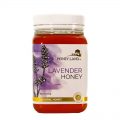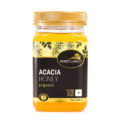It may seem intuitive to assume that crystallized honey is spoiled or poor quality, but this isn’t the case at all. Crystallization happens naturally over time to pure, raw honey and actually helps preserve the nutrients and quality. Additionally, you may find that crystallized honey is easier to spread and richer in flavor.
The Chemistry of Honey Crystals
The “why” behind the crystallization of honey is simple chemistry. Usually, honey contains at least 70% carbohydrates and less than 20% water. This is more sugar than can naturally remain dissolved and over time, crystals begin to form. Some honey crystals are fine and smooth while others are large and gritty. This is largely due to the proportion of the two main types of sugars found in honey, fructose and glucose. While fructose tends to remain dissolved, glucose has a much lower solubility. The higher proportion of glucose honey contains, the more quickly it will crystalize. More rapidly crystallized honey contains finer, smoother crystals. In fact, creamed honey is honey that has been crystallized so rapidly, that the minuscule crystals create a smooth, creamy texture.

Can You De-Crystallize Honey?
Yes! Honey can easily be de-crystallized in small batches through simple heating. Remember, however, that in order to preserve the natural nutrients found in honey, overly hot temperatures should be avoided.
You can easily de-crystallize honey on a stovetop using the following steps:
- Make sure your honey is in a glass jar or jars (not plastic). Fill a pot with water that comes to ½ to ⅔ up the sides of the jars.
- Place honey jars (sans lids) in pot and bring water to a hot but not boiling temperature.
- Gently stir honey every few minutes to help break up crystals. Be careful not to splash any hot water into honey jars.
- Remove jars from heat when honey is once again smooth and runny.
- Tightly seal jars and store in a cool, dry place
How To Keep Honey from Crystallizing?
Remember, crystallized honey happens naturally over time. Some steps, however, can be taken to minimize or delay crystallization.
- Maintain steady heat (104°-140°F) during honey bottling.
- Provide a quick, mild heat treatment (140°-160°F) to dissolve any crystals and expel air bubbles that could initiate crystallization.
- Store honey in proper containers. Air-tight, water safe stainless steel drums are recommended.
- Store honey in a cool (50°-70°F), dry location. Storage temperatures above 70°F will compromise the quality and nutrients of the honey over time. Refrigerated storage will quickly crystallize honey and should be avoided.







